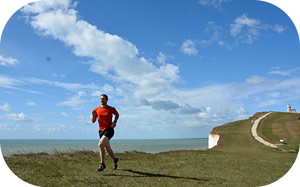Changes in Training or Equipment
 When runners experience ITBS, it is often the result of incorrect training techniques. In fact, 60% of all running injuries are the result of training errors. (Hreljac A., 2004) Incorrect techniques may include abrupt changes in the frequency or intensity of the training. If you feel that you need to change anything about your workout routine, it is wise to slowly incorporate the new tactics or terrain and possibly modify other aspects of your training. For instance, if you are going to push yourself to run a longer distance, you may want to make sure your terrain is easy. You would not want to increase your distance and force yourself to run up a lot of hills. Once you are accustomed to a longer distance, then you would be able to add a more intense terrain.
When runners experience ITBS, it is often the result of incorrect training techniques. In fact, 60% of all running injuries are the result of training errors. (Hreljac A., 2004) Incorrect techniques may include abrupt changes in the frequency or intensity of the training. If you feel that you need to change anything about your workout routine, it is wise to slowly incorporate the new tactics or terrain and possibly modify other aspects of your training. For instance, if you are going to push yourself to run a longer distance, you may want to make sure your terrain is easy. You would not want to increase your distance and force yourself to run up a lot of hills. Once you are accustomed to a longer distance, then you would be able to add a more intense terrain.
There are a number of activities that can be altered to change the same repetitive motions that cause ITBS.
- Altering your performance in training can be changed by training less, changing the stride length, staying away from hills or stairs, and even changing the direction in which you run.
- If you are a cyclist, consider an alternative seat or the height position it is in.
- If you climb stairs a lot during the day, consider researching information to make sure you are using proper technique. It seems simple enough to climb a set of stairs but most people won’t know that they are doing it “wrong” until they are already suffering from pain. The way your feet land in response with the ankle and how high you lift your thighs can impact the IT band and add unnecessary stressors to it.
- If because of your occupation, you find yourself in a crouching position most of the day, consider giving your knees (and your back) adequate rest in between. When you put your body in any position where the knee is turning back and forth repetitively, you increase your chances of creating friction on the IT band and the bursa sac near your knee joint.
- Footwear and orthopedic issues have their place in causing ITBS. If your shoes are worn down, your foot may land in an awkward position which can cause stress to the knee and hip. Most shoes have a recommended mileage. A common agreement between runners is that if your running shoes have over 400 miles on them, it’s time to change them out.
- If an individual has arch or ankle problems, you may be required to obtain some orthopedic (orthotic) athletic shoes so that a runner or athlete's gait is unaffected.
- Keep in mind to try and experiment with different types of shoes. It may take a while to find the right corrective footwear for your specific activity, but don’t give up. It will be worth the wait in the long run not having to deal with the symptoms of ITBS.
- If you are a runner, don’t forget that not all running shoes are designed for every terrain out there. Consider your shoes and if they match the terrain you jog or run on. You can also decide to switch the terrain you run on altogether. If an individual trains cross-country, they might try switching to a harder surface for a small amount of training. Again, make sure the shoes that you wear match the terrain you exercise on.

